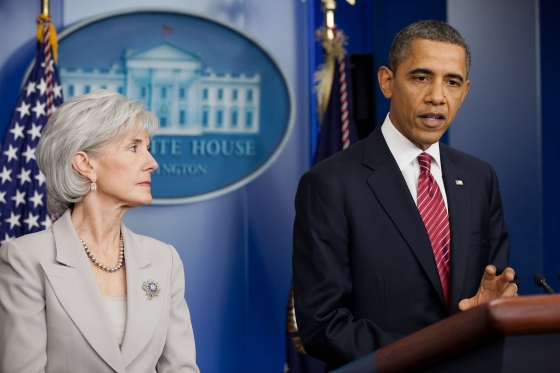2017 Wisconsin Health Insurance Cost Ranking
Milwaukee Area Still Has Above Averages Costs

Former Health and Human Services Secretary Kathleen Sebelius and President Barack Obama. Official White House. Photo by Pete Souza.
Statewide: Citizen Action of Wisconsin released its 11th Annual Wisconsin Health Insurance Cost Ranking report Wednesday morning on a statewide media call. A full audio recording of the media call can be downloaded here.
The full report includes 11 charts ranking the cities and regions of Wisconsin on health insurance costs, rate of inflation, and quality, and can be downloaded here.
This year’s report finds wide disparities between higher and lower cost regions of Wisconsin, as well as large differences in the rate of health insurance inflation, causing some Wisconsinites to pay thousands of dollars more than others in less expensive regions of the state.
New in this year’s report is an analysis of the rate of health insurance hyperinflation in each Wisconsin city before and after the Affordable Care (ACA) was fully implemented. The report finds that the rate of health insurance hyperinflation was over 7x higher in the 13 years before the implementation of ACA than it has been in the 4 years since (15% per year statewide before vs 2% per year after). In some Wisconsin cities, the decline in the rate of inflation is even more dramatic. These results call into question the claim that the health care law caused health insurance rates for most health consumers to dramatically increase, and the contention that repealing the ACA will lower the cost of health coverage.
Overall, the report finds that Wisconsin health insurance premiums for large and medium sized employers have more than tripled since 2000, increasing 226% since the year 2000 statewide, and as much 381% in some areas.
Key Findings: Wisconsin Health Insurance Cost Ranking 2017
- Wisconsin Health Care Hyperinflation is a Long Term Trend. Wisconsin large group health insurance costs (premiums and deductibles) have more than tripled since the year 2000, increasing 226% statewide, with regional rates of inflation varying between a low of 168% in Madison to highs of 381% in Green Bay, 265% in Appleton, 263% in Oshkosh, and 231% in Milwaukee, for benefits packages that is less generous.
- The Rate of Health Care Hyperinflation Was Much Higher Before the Implementation of ACA. The rate of health insurance hyperinflation was 7x higher in the 13 years before the implementation of ACA than it has been in the 4 years since (15% per year statewide before vs 2% per year after). In some Wisconsin cities, the decline in the rate of inflation is even more dramatic.
- North Central Wisconsin and Northwestern Wisconsin are Highest Cost Areas, Madison is Lower Cost. According to a new composite measure which combines all types of health insurance the North Central and Northwestern parts of the state have the highest cost health insurance whereas Madison has the lowest. Southeast Wisconsin is also very high.
- Regional Cost Disparities Persist. There continue to be wide cost variations between higher and lower cost areas of the state. The cost variation is even higher in our composite index for all types of health insurance than they are in the large group market. There is a 34.7% cost variation between the highest cost metro area (Wisconsin Rapids and Marshfield) and the lowest cost metro area (Madison), which amounts to a $2,578.74 difference for a single policy each year.
- Regional Cost Disparities Are Greatest on the Individual Market. Although there are large regional cost variations for all types of insurance, the biggest disparities are in the individual market. The highest cost areas (Wausau, Stevens Point, Wisconsin Rapids, and Marshfield) are an astounding 84% higher than the lowest cost area (Madison). This amounts to a gap of $5,335 per year for individual coverage.
- Disparities Within Regions Suggest Underlying Medical Costs are Not the Only Driver of Insurance Costs. Insurers often claim that their prices merely reflect medical costs. However, there are major variations in relative cost within regions for different types of insurance. This suggest that the numbers measure not only underlying medical costs but also distortions in the insurance market. For example, the Fox Valley has above average insurance rates in large group insurance and well below average rates in the individual and small group markets. Wausau has very high costs for large group and individual market insurance, but relatively low costs in small group. Madison is not nearly as low in the small group market as it is for the other types of insurance. (Charts 2, 5, & 6).
- Cost and Quality are Not Correlated. As in past reports, the 2017 report finds that there is no clear correlation between quality and health insurance costs, with some of the low cost areas of the state having higher quality insurance plans and some higher costs areas having relatively lower quality plans.
“The striking numbers in this report make it clear that state lawmakers need to move beyond the divisive debate over the Affordable Care Act and put a sharp focus on making health care truly affordable,” said Robert Kraig, the report lead author and the Executive Director of Citizen Action of Wisconsin. “It is absolutely stunning that health insurance premiums have tripled since 2000, yet the Governor and the Legislature are doing nothing to address the crisis. Wisconsin workers and families will not have full control of their own health care decisions until we make health coverage affordable for everyone in Wisconsin.”
“My youngest daughter has had epilepsy since she was ten and I have a few minor conditions, but in our small business we could not get private coverage because of our pre-existing conditions and were relegated to the state’s High Risk Pool”, said Tammy Wolfgram, small business owner of Songbird Hills Golf Club in Hartland WI. “We were paying the High Risk Pool over $1,000 per month with a high deductible that went up each year. When the Affordable Care Act started we didn’t need to worry about being rejected because of our pre-existing conditions. Before the law I couldn’t find insurance for an 11 year old, that is very concerning.”
Additional data and 11 ranking charts ranking each metro area in Wisconsin are available in the full report which can be downloaded here.
NOTE: This press release was submitted to Urban Milwaukee and was not written by an Urban Milwaukee writer. While it is believed to be reliable, Urban Milwaukee does not guarantee its accuracy or completeness.
Mentioned in This Press Release
Recent Press Releases by Citizen Action of Wisconsin
Citizen Action Praises Advances in Health Care in Evers Budget; Calls for Use of Veto Power to Force the Issue
Feb 18th, 2025 by Citizen Action of WisconsinCalls on Governor to Use Veto Powers to Leverage BadgerCare Expansion
Citizen Action Stages Protest of We Energies in Frigid Conditions
Dec 23rd, 2022 by Citizen Action of WisconsinCalls out 11% price increase, discriminatory rates for low income people of color, foot-dragging on climate crisis





















